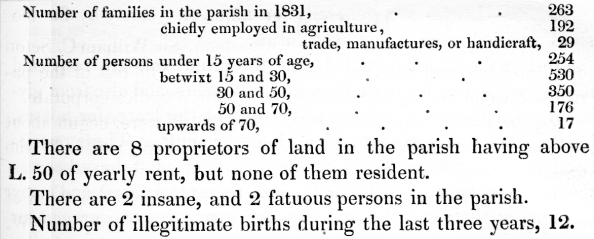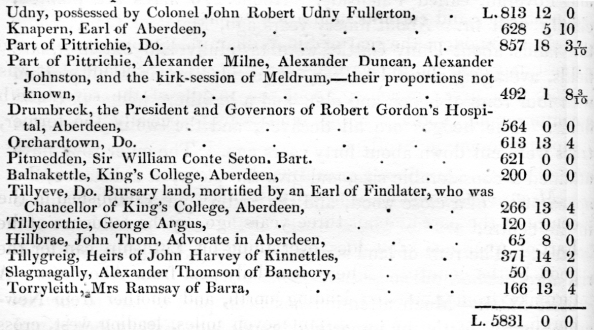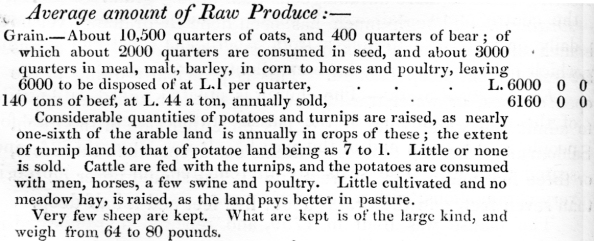|
PRESBYTERY OF ABERDEEN,
SYNOD OF ABERDEEN.
THE REV. JOHN LESLIE,
MINISTER.
I.—Topography and Natural
History.
Name.—Udny derives its name
from a family, which, for many centuries, has possessed the barony of Udny,
on which the kirk stands. The etymology of Udny is not known. It was
erected into a parish by act of Parliament, passed 19th December 1597,
entitled "Ratification—Ane Act anent Christ's Kirk of Udny" being
separated from the parishes of Ellon, Tarves, Logie Buchan, and Foveran.
The lands taken from Ellon and Logie Buchan still pay small sums out of
the teinds of these lands to the ministers of Ellon and Logie Buchan.
Extent and Boundaries,
&c.—The parish is almost circular, except on the north-east, where it juts
out to a considerable extent. It is supposed to contain about 16 square
miles. It is situated in the district of Aberdeenshire called Formartin,
and is bounded on the north and north-west, by Tarves; on the west, by
Bourtie; on the south-west, by Keithhall; on the south, by New Machar and
Fintray; on the south-east, by Belhelvie; on the east, by Foveran; and on
the north-east, by Logie Buchan and Ellon.
Three small streams run
from west to east till they terminate in the river Ythan, about six miles
distant. Two of these streams bound the parish,—the one on the south, the
other on the north.
Abundance of granite, and a
vein of limestone, runs from southwest to north-east in a zig-zag
direction. In many places the vein is covered with a stratum of grayish
slate, and the lime-rock is all more or less mixed with the slate, which
injures the quality of the lime.
Lime-works have frequently
been started; but are never worked to any extent, as the water breaking in
upon the quarry, and the inferior quality of the lime, render them a
losing concern.
The soil is for the most
part loam, on a bottom of granite, and sometimes on clay. The granite
bottom is under the best soil.
II.—Civil History.
Proprietors.—These are,
Earl of Aberdeen, Sir William C. Seton of Pitmedden, and Colonel Udny of
Udny. The rest of the parish is divided among eight heritors and three
bodies corporate.
Registers.—A baptism and money register were begun about the year 1720,
but have been very irregularly kept, especially the former.
Mansion-Houses.—In 1819, a neat mansion-house
was built of granite, on the estate of Pittrichie, then the property of
James W. Mackenzie, Esq. The property now belongs to Alexander Milne, Esq.
On the barony of Udny is a Castle, supposed,
from its shape, to have been built about the end of the thirteenth, or
beginning of the fourteenth century. Its dimensions are, length outside 46
feet; inside 28 feet; breadth outside 35 feet; inside 17 feet; height 71
feet. The walls are
thick enough to admit of bed-closets within them. The two under-stories
are vaulted, the upper one of which contains a spacious hall, the whole
length and breadth of the castle. It is neatly floored, or rather
pavemented, with oblong hexagonal granites, very neatly joined. Its height
to the top of the arch is about 20 feet.
An attempt was made in 1801 to modernize the
castle; but the undertaker of the work having failed in circumstances, it
remains in an unfinished state. The castle is said to have been the work
of three successive proprietors, who all lived the ordinary period of
life. One built the two under-stories, or the vaulted work, the next
completed the walls, and the third put on the roof. It is reported that
all the three were nearly ruined by it. This is not to be wondered at,
when we consider that they had only the barony of Udny, not 400 Scots
acres in extent; and at that time there could , not be more than 60 acres
in cultivation. The present proprietor has extensive estates in this
parish, likewise in Ellon and Foveran.
At Tillygreig, the seat of Arthur Harvey, Esq.
is a small mansion, suited to the estate, which rents about L. 500. It is
about to be repaired and enlarged. At Pitmedden are two mansions, both in
ruins.


IV.—Industry.
Agriculture.

About 60 acres may be supposed to fall to
Hillbrae, in the parish of Udny, of an undivided common between Udny,
Belhelvie, and Foveran, called Faichside. About 270 acres are planted,
chiefly with fir. About ninety years ago, Mains of Udny, being the lands
about Udny Castle, were tastefully laid out in square fields, averaging
about 16 acres, and divided by lanes, all planted with four rows of beech
and elm, and a hawthorn hedge next the fields. The hedges are all decayed.
and the two inner rows of trees were cut down about forty years ago. The
outer rows have attained a considerable size, and give the place, at a
distance, the appearance of a close wood, and the castle appears to
advantage in the centre.
Rent.—The rent of land is a trifle under L. 1
Sterling an imperial acre.
Live-Stock.—Much attention has been paid of
late to the improvement of cattle, by importing breeds from Kirkcudbright
and Durham; but the Aberdeenshire breed, mostly black without horns, suit
the country best, as they thrive upon inferior keep. Rearing cattle is
more advantageous than raising grain.
Draining.—Though much has been done by
draining, yet no branch of improvement has been less attended to. The
drains are seldom cut deep enough. This is principally owing to the open
ditches, or water tracks, not being cut to a sufficient depth to admit the
water from the drains on either side of the ditch. Seldom are either the
ditches or drains cut deeper than three feet, or three feet and a half,
whereas the ditches should never be less than seven feet, and the drains
about five feet and a half deep.
Leases.—Leases are generally for nineteen
years—by far too short a period upon unimproved farms.
Most of the land is entailed, and the
proprietors are restricted from giving leases for more than nineteen
years, and also from giving more than one year's rent at the end of the
lease, for houses, fences, drains, &c. in short, for all improvements.
These restrictions were long acted up to by the proprietors, but have been
as much as possible departed from by them for several years; and many of
them, at their own risk and expense, give great encouragement to
industrious tenants. There is an emulation, in most cases, between the
proprietor and his tenants, whether the former shall be the more liberal,
or the latter the more industrious. The result has been, that the rental
of the parish, about forty years ago little more than L. 2000, is now
above L. 7000, and the farmers' capital has increased more in proportion
than the rent. The valued rent of the parish is L. 5831 Scots, divided as
follows:—

Quarries.—There are granite and limestone,
both worked with iron levers and hammers, and the rock occasionally burst
with powder.


Formerly, a considerable sum was realized
annually for poultry. Now, the farmers can afford to use all their poultry
themselves, and none is sold but by the cottars and tenants on small
possessions. The
butter and cheese, especially the former, made in this parish, are
considered of superior quality. This is owing to most of the land being on
an open or rocky bottom, producing fine grass.
The land is managed generally under a six or
seven shift. In the former case, which only answers with the better land,
one-half of the farm is under grain, one-third under grass, and one-sixth
under turnips and potatoes. There is little clay land in the parish, and
consequently little fallow. All the farmers have small gardens for raising
vegetables for their families. In many of them are raised gooseberries and
currants, and a few apples.
At Pitmedden, the seat of Sir William C.
Seton, is one of the finest and best laid out gardens in the north of
Scotland. It was made at a great expense, about the middle of the
seventeenth century, and produces apples and pears, especially the former,
superior to any in Scotland.
V.—Parochial Economy.
Means of Communication.—A
post-office was established in the centre of the parish about three years
ago, by the influence of the Earl of Aberdeen, who does everything his
Lordship can for the good of the country. There is a daily post from
Aberdeen. A turnpike from Aberdeen leading north, and another from
New-burgh, the nearest port, distant seven miles, leading west, cross each
other in the centre of the parish. The line of turnpike between Aberdeen
and Meldrum passes through the west part of the parish, nearly parallel
with the road from Aberdeen through the centre of the parish. A public
coach passes and repasses daily on both the turnpikes from Aberdeen. All
the streams which public roads cross have excellent stone bridges.
Ecclesiastical State.—The church is situated
within half-a-mile of the north boundary of the parish—rather
inconveniently for people in the south end of the parish. It was built in
1821, and seated for 750. The seats are all rent-free, and the church is
very commodious, with a neat low spire.
The manse was built in 1759, and repaired and
enlarged in 1781. The glebe consists of about 7 imperial acres, 4 of good
land, 3 of bad—value L.10 per annum.
The stipend is 16 chalders of victual, half
meal half barley— barley Linlithgow measure.
About 280 families in the parish, and, in
general, between 500 and 600 persons attend the Established Church every
Sabbath. There are 8
families of Episcopalians, and 7 of Seceders in the parish.
The Established Church is remarkably well
attended. Within the last seven years, the number of communicants has
increased from 527 to 598.
Education.—There are two schools,—one
parochial and the other on the teacher's own adventure. The latter
receives small sums from some of the heritors occasionally as a reward.
Salary of parochial school is L. 32; amount of fees of each school about
L. 20 a year. The parochial schoolmaster has the legal accommodation.
School-fees per quarter, 2s. for English; 3s. for English and writing; 4s.
for arithmetic; and 5s. for Latin. Till the present parochial schoolmaster
fell into bad health, when it was given up, an academy was kept at the
parochial school for nearly fifty years, attended by from 20 to 30
gentlemen's sons, at L. 30 a-year for board and education. The academy was
the means of giving better education to the parishioners than any of their
neighbours had an opportunity of obtaining. Many of the younger farmers
belonging to the parish, who received their education at the Udny Academy,
attended several sessions at the Aberdeen universities. . Some of the
parishioners' sons became professional men, who, had it not been for the
academy, would have been in humble life.
There is not a person in the parish above
fifteen years of age who cannot read and write.
Poor and Parochial Funds.—About 31 receive
parochial aid, at the average rate of L. 1, 16s. per annum. Besides these,
several are maintained at from 2s. to 3s. per week, and many get
occasional supplies.
Average collection on Sundays at the church 10s. The poor's fund has also
the interest of a mortified sum of L. 350. Use of mortcloth yields about
L.2, 15s. per annum; and fines for immoralities L. 3 per annum; accidental
legacies, in small sums, may yield L. 8 per annum, and gifts from
charitable individuals may yield L. 4 per annum. It is much to be
regretted that many of the poor, when once they receive a little relief,
anxiously look for more; and when they once receive relief, it too
frequently breaks the spring of industry, and renders them quite
dependent.
Fairs.—Three fairs are held at Green of Udny, chiefly for disposing of
black-cattle. The fairs are well attended.
Inns.—There are 7 inns, by far too many, as
they have a very bad effect on the morals of the people.
Fuel.—Formerly peats were the only fuel,
procured at a great waste of time and labour, though little or no money
was laid out for it. Now, about one-half of the fuel is coals, bought at
Aberdeen and Newburgh, at about 4s. the imperial boll of 36 stones. Coals
are much cheaper than peat.
Miscellaneous Observations.
At the time of the former Statistical Account,
forty-six years ago, a great proportion of the parish was covered with
broom, whins, and bulrushes. These are now extirpated, and the eye meets
with nothing but cultivated and mostly enclosed fields. Fewer hands are
now employed in agriculture than were formerly, in proportion to the
extent cultivated. The improved method of working, especially the
thrashing-machines, as every farm above fifty acres has a
thrashing-machine, has greatly diminished human labour. The consequence
has been, that many of the labourers have repaired to Aberdeen, or where
they could find employment, which accounts for there being more births
than burials in the parish. About forty years ago, there were ten meal
mills in the parish. The spare grain was all milled and sold in Aberdeen.
There are now only three meal mills in the parish. These have not constant
employment. The farmers mill little more than what is sufficient for their
families. It is found more advantageous to sell grain than meal.
In the parish are 8 blacksmiths, 8 shoemakers,
5 tailors, 5 wrights, and 3 masons. Most of them work by the piece. There
are 2 gardeners, who work at 1s. 6d. per day, with victuals. Farm-servants
compose the chief body of the people. They are sober, industrious, and
trustworthy. Some of the tradesmen are dissipated. There are 6 merchants
in the parish upon a small scale. They all retail groceries and coarse
cloth. Most of them sell spirits, which circumstance has a strong tendency
to hurt the morals of the people. The farmers take most of their groceries
from Aberdeen. Many of the cottars and small tenants barter their butter
and eggs with the country retailers, for groceries.
A few weeks before Whitsunday and Martinmas,
markets are held in different parts of the country for engaging
farm-servants. The best sign of the times is, when the servants are
scarce, and wages high.
January 1840. |

